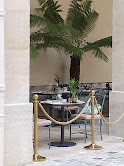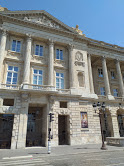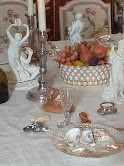In front of the palace balcony, French history has been played out, from the Liberation of Paris in 1944 back to the tragic firework display of May 1770 celebrating the marriage of Marie Antoinette and the future Louis XVI. The fireworks store caught fire and hundreds of people died. The arcades of the building were full of people fleeing. Many drowned in the Seine. The event was later seen as a bad omen for their marriage. It certainly was. 23 years later, in January 1793, Louis XVI was guillotined on the square and 8 months later his widow Marie Antoinette followed him.
The impressive palace was built for Louis XV by architect Anges-Jacques Gabriel to form the Northern side of a new royal square. Along with the symmetrical palace to the left which now houses the hotel Crillon and the Automobile Club, the 2 buildings formed a backdrop to Bouchardon's horseback statue of Louis XV (toppled and melted down at the Revolution and later replaced by the Egyptian obelisk).
The palatial building was turned into the royal furniture store by the king. The Intendant's responsibilities were to look after and maintain furniture, weapons, jewels, and furnishings, right down to the king's kitchen utensils. His role was also to purchase items of quality.
The building's second period, starting at the Revolution, was as the Admiralty, or Naval Ministry, hence its name: hôtel de la Marine. The Ministry moved in when Louis XVI returned from Versailles in October 1789 at the beginning of the revolutionary events and it stayed there until 2015.
On the 13th July, 1789, the palace was raided and the arms which were stored there were taken by the mob who went the next day to the Bastille for gun powder and ended up storming it. The 14th of July became 'Bastille Day', as the English-speaking world calls it. Some weapons were really not meant to be used, like the small decorative canons given to France as a diplomatic gift by the monarch of Siam.
At first the rest of the store was not pillaged, but then, between the 11th and 16th September 1792, a spectacular burglary took place. The crown jewels were stolen. The few that were recovered are now to be seen in the Louvre, including the "Regent", France's biggest diamond. 5 of the culprits were later caught and guillotined in front of the building. Many more managed to get let off or were imprisoned. It had been so easy to get in there, by scaling up the stepped stones around the colonnade giving onto the square, that the last night turned into a party and the noise attracted the authorities! The famous "French Blue" diamond was never found. Only very recently has it been proved that it became the Hope diamond, now in the Smithsonian, Washington.
 |
| The view from the balcony is more peaceful nowadays |
In 1848, a major event took place in the building: the definitive abolition of slavery by senator Victor Schoelcher and committee. 250,000 French slaves were liberated in the colonies. There is a large round screen/table in one of the last rooms, where visitors can select real-life characters and follow their history. One of them is a slave. His transportation by ship is described in its horrific reality.
Another character to discover on the hands-on screen is explorer Lapérouse, about whose progress Louis XVI is supposed to have enquired on his way to the guillotine. The French sailor disappeared without trace in 1788, while following in the wake of Captain James Cook and charting the Pacific for king Louis XVI. One of Lapérouse's 2 frigates, 'La Boussole' ('the Compass') was detected only recently, in 2005, down a crevice in the ocean near the Solomon islands.
 |
| Lapérouse |
In the 19th century, when the square outside was remodelled, the 2 fountains were dedicated to the seas and rivers of France and the decorative lamps were designed to look like prows of boats, thus linking the square to the Admiralty.
The Naval Ministry installed portraits of eminent French sailors in the golden galleries.
 |
| Tourville, naval commander under Louis XIV |
Because the restoration team took the (rare) decision to scrape the walls right down to the foundations of the decor rather than recreating it, many complete original panels have been revealed. This excellent result is mainly thanks to the sailor-style method of painting over the top of the old paint, just as when a ship needs painting, the sailors paint over all the briny corrosion.
Amongst the 18th century golden elegance, the very modern revolving screens may shock the eye, but provide interesting videos , showing, for example, scenes of the Liberation of Paris. (During the Occupation of Paris the German Navy was stationed in the building and kept an eye on the approaches to the nearby hotel Meurice where the German governor was housed)

An ingenious and pretty way has been found to remind visitors not to sit on the precious chairs: by placing thistles on them!
Several marquetry floors have been restored magnificently.
The restorers claim that the hotel de la Marine is more authentic than Versailles (at most 40 % original, whereas the Marine is 70%).
The National Monuments body in charge of the museum has devised an entertaining self-visit, using state-of-the-art headphones to evoke figures from the past and to connect with animated screens. It is a little creepy to hear Fontanieu, the resident Intendant of the palace in the 18th century, speaking in the headphones. I saw people glancing behind them to catch sight of the 'ghost' speaking to them!
2 choices of visit are on offer to visitors: the classic "grand siècle" (18th century) or the" travel through time" tour. They are aimed at visitors of all ages.
Some of the new widgets may come as a surprise- for example I was astonished to see a portrait of the great ébéniste (furniture maker) Riesener move his lips and speak to me through the headphones. Disconcerting! Somewhat Harry Potterish.
Marie Antoinette is for the moment silent. Perhaps this is a wise choice on the part of the animators, since no doubt many French and also international visitors might question the exactness of her speech or looks, whereas noone knows too much how Riesener looked and spoke. Furthermore he speaks several languages (the visit is available in 3 languages: French, English Spanish).
The first man in charge of the royal furniture depository, Pierre Elisabeth de Fontanieu, had exquisite taste. He was reproached for living more luxuriously than the king, but his justification was that he was testing everything to make sure it was good enough for Louis XV.
Intendant Fontanieu was not only a fine connaisseur but a bachelor and a libertine, in the 18th century sense- a free thinker, not bound by convention. This led naturally to freedom of the senses.
Fontanieu's bedroom is a rich sensuous red. Unfortunately, the original furniture is in Boston, but the decorators have done a good job in finding similar pieces.
A small room adjoining the bedroom was lined with mirrors, painted with naked ladies and lit by a magic jewelled lighting effect.
However, Fontanieu's replacement in 1784, Marc Antoine Thierry de Ville d'Avray, was a married man, whose wife had soft pink robes painted on the naked ladies. She also added several delicate cherubs.
Fontanieu even possessed a very small room (not visible on the visit) for 4 to 6 visitors maximum, where the centre piece of the table could descend mechanically to the basement and be replenished with victuals by the staff, so that no servants would disturb him during a private dinner. Even Louis XV never quite achieved such an intimate set-up, although he planned it at Versailles.
One of the Intendant's skills was fabricating false precious stones. He used his decorative prowess to create sumptuous surroundings for the furniture and had the brilliant idea of opening the furniture store to visitors, on the first Tuesday of the month in the summer months. Thus the palace, in 1778, became France's first decorative arts museum, 15 years before the Louvre opened its doors to the public. Now, two and a half centuries later, it is again a showcase of French 'grand siècle' decor.
 |
| Intendant's study with desk by Riesener |
The pair of expert decorators have effected a most sensitive restoration of the palace, aiding Mme Delphine Christophe, director of conservation. In the interests of authenticity, the 3 of them travelled to Venice to search out 18th century material, then to Lyon, the traditional silk-producing town of France.
Where they could not find the real pieces, they searched antique dealers' shops for similar ones.
In the first antechamber, there is a fountain which provided a hand-washing place for guests.
The fountain had disappeared. The replacement one is as near the original as possible; it was found in a left-bank antique dealer's showroom.
Messieurs Achkar and Charrière's first task was to read through the 900 pages of the 1775 inventory by Fontanieu, where he described pieces in full detail. They said they got a feeling for the workings of the place and its atmosphere, which they have contrived to recapture.
Little touches, like a fan left negligently on a table or a waistcoat draped over a chair give the impression that the place is lived in.
In Mme's bedroom, for example, next to her bed is a pretty kennel for her pet animal.
Another example of an amusing 'lived in' touch is the potty desguised as a stack of books when not in use.
A nice clutter of books, purses left on the gaming tables or discarded oyster shells in the dining room add to this feeling. The oysters were inspired by a painting of a dining scene (at Chantilly) by François de Troy.
The café in the courtyard is an oasis from the city traffic and can be patronised without visiting the museum.
 |
| It is named after the ill-fated explorer Lapérouse. |
Hotel de la Marine, 2 place de la Concorde.
Open 7/7 (except some National holidays)
Visits from 10h30am to 7pm . Late opening Friday until 10pm.
Courtyard open from 9am to 1 am.

























Comments
Post a Comment